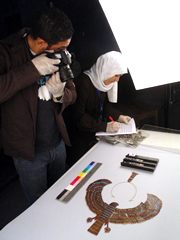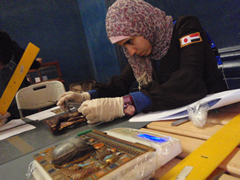- Home
- Technical Cooperation Projects
- Index of Countries
- Middle East
- Egypt
- The Project for the Conservation Center in the Grand Egyptian Museum
- Project News
- Beginning of working with the King Tutankhamen collection
Project News
2011-04-01
Beginning of working with the King Tutankhamen collection
 ADD staff members photographs the pectoral of the King Tut
ADD staff members photographs the pectoral of the King Tut
Currently we are working on making archeological database includes the artifacts that will be in the Grand Egyptian Museum (GEM), as a part of the project. Our competent team revises the old archeological records of the selected artifacts for the GEM to make sure that all the data in the database are accurate. The accurate data is very important for planning of transportation and exhibition design of the museum.
An archeological unit had begun to work on archeological database of the selected artifacts for the GEM for several years. However, there were some misinformation and duplication of data, such as pictures, sizes and places of storage and exhibition.
In August 2008, JICA nominated a team of youth specialists in Egyptology to be the staff of Archeological Database Department (ADD). They are working on re-structuring the database under the supervision of IT Japanese expert. The team now consists of 16 persons. Their work routine is to go to artifact storerooms, to confirm stored places, their sizes and other relevant data, and re-photographing original artifacts.
The team, since it was organized, has made revision of all the data of about 10 thousand artifacts at well-known archeological sites such as Saqqara, Giza, El-Mansoura and other storerooms all over Egypt. They have also started their work in Egyptian Museum in Tahrir, since April 2010.
The Egyptian government decided to make a partial inauguration for the Grand Egyptian Museum with 12,500 exhibited artifacts. 10,000 of these objects are from the Egyptian Museum, including the Tutankhamen collection. Therefore, the ADD team reset their aim to work on 12,500 artifacts, instead of 10,000. They already work on 5,000 artifacts by mid-January 2011.
In December 2010, the ADD team started working on the collection of the King Tutankhamen (Tut), which is shown in the second floor in the Egyptian Museum in Tahrir. Working with the world-famous confection is like a dream for the Egyptologists, so the team was very proud of it. All of the ADD work is conducted in cooperation with curators of the Museum, with the presence of security personnel. The Curators carefully took out the King's artifacts one by one from exhibition cases. ADD team measured their dimensions and weights and re-took photos. From 12 January 2011 they started revising the data of objects on display in the Golden Hall No.1 where the Golden Mask of Tut is placed.
 A staff member measuring a part of the Tut collection
A staff member measuring a part of the Tut collection
Finally, the glass cover was raised from the Golden Mask of the King on Wednesday 19 Jan. 2011. This time they only photographed the mask, because the measurement has been done in the past. The museum opens to visitors till midday on Wednesday. It was the only time to work directly with the famous golden mask of the young king. The glass case that protects the mask is rarely taken off. Though the gallery was closed to visitors, it was full of journalists of major TV channels and newspapers who wanted to catch this rare occasion. Admiration aroused in the room for the beauty and magnificence of the mask.
ADD team continued working with the Tutankhamen funerary objects until March 2011, with a short interruption by the January 25th revolution in Egypt which centered the Tahrir square where the museum stands.
- About JICA
- News & Features
- Countries & Regions
- Our Work
- Thematic Issues
- Types of Assistance
- Partnerships with Other Development Partners
- Climate Change / Environmental and Social Considerations
- Evaluations
- Compliance and Anti-corruption
- Science and Technology Cooperation on Global Issues
- Research
- JICA Development Studies Program / JICA Chair
- Support for the Acceptance of Foreign HRs / Multicultural and Inclusive Community
- Publications
- Investor Relations
